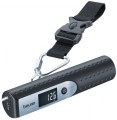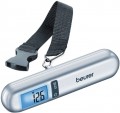Max. measurement weight
The largest weight that is allowed to be placed on the platform of this scale model. If this parameter is exceeded, the scales, at best, will not be able to show the correct data, at worst, they will completely fail. Obviously, the maximum weight is directly related to the purpose, but even kitchen scales can weigh both
up to 5 kg and up to 20 kg.
Actually, floor scales have the largest maximum measurement weight, in such models it can reach
200 kg or even more. And the most delicate are
jewelry models (refer to "Type"). Also note that in mechanical devices (refer to "Mechanism") the scale is usually graduated to the maximum weight.
Now on the market there are scales with such a maximum weight:
up to 1 kg,
up to 5 kg,
up to 10 kg,
up to 50 kg,
up to 150 kg,
up to 200 kg.
Functions
—
Tare compensation. The capacity to factor in the weight of containers or packaging when weighing materials is a common feature. Typically, this function operates by placing an empty container (like a box or measuring cup) onto the scale and resetting the scale's measurement (via a button press or a specific knob turn). Consequently, when the container is filled, the scale displays only the content's weight, excluding the container's weight. Some models even allow for manual adjustment of any additional weight that shouldn't be considered.
—
Measurement of volume. The capability to measure liquid volume is a function present exclusively in kitchen scales (as outlined in "Weighing type"). It's executed through various methods. For instance, some models incorporate a divided bowl that functions as a measuring cup, operating on a similar principle. In other models, users can select the liquid type (water, milk, vegetable oil, etc.), and the scale will automatically compute the volume based on its weight. This function proves valuable when precise ingredient measurement is of utmost importance.
—
Automatic activation. Automatic activation of electronic scales when a load is placed on them. Small, but quite handy option.
—
Automatic shutdown. This function ensures that the electronic balance (see "Mechanism") turns
...off some time after the load has been removed from it. Thanks to auto-off, you can not be afraid to run out of batteries by forgetting to turn off the device. And in some models, manual shutdown is not provided at all — only automatic.
— Voice notification. Scales incorporating a voice notification feature offer audible results, typically relayed through the device's speaker. This function is commonly found in bathroom scales (as discussed in "Type of scales"), where it holds significant relevance. It caters to users who may have difficulty viewing the display without leaning or those who might find leaning inconvenient or impractical due to health issues. Voice notifications can be provided in various languages, allowing users to select their preferred language from the available options.
— Calorie calculator. This function enables the calculation of the nutritional content of weighed items, typically focusing on calorie count, although more advanced models might incorporate additional parameters like protein, fat, carbohydrates, fiber, and liquids. The scale stores information about the nutritional values of various products. When weighing, users select a specific item from this list to determine its caloric content. While theoretically useful for those meticulously monitoring their diet and calorie intake, the accuracy of the calorie calculator often provides only approximations, which may not align precisely with actual values. For instance, while the calorie calculator can accurately estimate the nutritional value of fruits and vegetables, it tends to provide general average values for grains. However, the actual calorie content of foods like porridge varies based on preparation methods. Thus, the calorie calculator should not be solely relied upon; for more precise nutritional information, consulting specialized tables and calculation methods is advisable.
— Timer. Including a timer feature in scales enables users to set countdown intervals. The user establishes a desired duration, initiates the timer, and receives a signal when the set time elapses. This functionality proves beneficial across various applications, with particular utility in the kitchen where precise time control is frequently required during cooking. Consequently, the majority of scales equipped with a timer are categorized as kitchen scales (refer to "Type of scales").
— Thermometer. Availability of the built-in thermometer in scales. Usually, this function is performed by a simple thermal sensor that determines the ambient temperature; and most scales with such equipment are kitchen scales or floor scales (refer to "Type of scales"). Note that in fact, the need for a thermometer occurs relatively rarely, and this function is more of a “nice addition” than a serious functional advantage. However, such equipment has almost no effect on the cost of scales — thermal sensors are very inexpensive.
— Synchronization with a smartphone. The capacity to link scales with a mobile device (smartphone, tablet) for data exchange is a prevalent feature. Generally, this involves installing a designated application, which might even be provided alongside the scales. The specifics of this connection and its functionalities can vary, contingent on the type and model of the scale. This feature is commonly found in floor-standing diagnostic scales, where measurement data is used to maintain a record of body information. It particularly benefits athletes, fitness enthusiasts, and individuals using physical activity for therapeutic purposes. Notably, compatibility extends beyond proprietary software to encompass third-party medical and fitness services. Another category of devices featuring synchronization capability is kitchen scales, where the accompanying application is employed for working with various culinary recipes.Power source
The vast majority of electronic scales are powered by a battery pack. But some models may have a
built-in battery, which does not require constant replacement. Just remember to recharge the scales.
Battery powered scales can use different types of batteries:
—
AA — the format of the classic "finger" batteries;
—
AAA — "microfinger" batteries;
—
CR2032 — the so-called coin type. Many PC users are familiar with this battery format. "Coins" are used to power BIOS memory in motherboards.
In addition to the type of batteries, you also need to pay attention to their number in the battery compartment.

